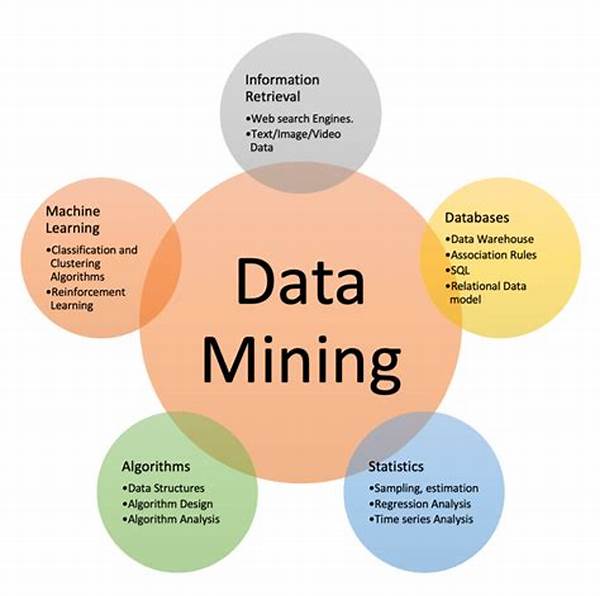In the contemporary era of technological advancement, machine learning and data mining stand as pivotal foundations for innovations across numerous fields. As integral components of the broader domain of artificial intelligence and data analysis, they offer unparalleled capabilities in deciphering complex data patterns and delivering actionable insights. Understanding these concepts not only fuels technological progress but also empowers stakeholders to harness data-driven decision-making effectively. The scope and applicability of machine learning and data mining stretch across various industries, enhancing efficiencies and fostering innovation. This article delves into the nuances of these transformative technologies, exploring their impact and significance in today’s data-centric world.
Read Now : Cross-platform Api Development Strategies
The Core Concepts of Machine Learning and Data Mining
Machine learning and data mining, though interrelated, serve distinct roles in data analysis. Machine learning, a subset of artificial intelligence, is designed to enable machines to learn from data systematically. This learning process involves training algorithms on a given dataset to make predictions or take decisions without explicit programming by human operators. In contrast, data mining refers to the process of discovering patterns and extracting valuable information from large datasets. It encompasses several techniques, including clustering, association, and classification, which help in making sense of complex data. While machine learning often utilizes data mining processes to gather initial insights, it extends further by allowing predictive analysis and providing the capability to adapt over time. These technologies, when used conjointly, unleash a potent approach to uncover hidden trends, correlations, and patterns, driving innovation and enhancing decision-making processes across industries.
Applications of Machine Learning and Data Mining
1. Healthcare: Machine learning and data mining are instrumental in the predictive analysis of patient data, aiding in early diagnosis and personalized treatment plans.
2. Finance: These technologies enhance risk management and fraud detection by analyzing transaction patterns to identify anomalies and predict potential risks.
3. Retail: By analyzing customer purchasing patterns, machine learning and data mining help in inventory management, improving customer experience, and personalizing marketing strategies.
4. Manufacturing: Predictive maintenance is made possible through these technologies, optimizing machine uptime and reducing operational costs by analyzing historical equipment data.
5. Education: They enable the customization of learning experiences by monitoring student performance and suggesting personalized learning paths.
Challenges and Considerations
Implementing machine learning and data mining technologies poses certain challenges that require careful consideration. Data quality and integrity remain crucial factors influencing the outcome of any analysis. Inaccurate or incomplete data can lead to erroneous conclusions, thereby affecting the reliability of results. Furthermore, ethical considerations surrounding data privacy and the potential for algorithmic bias demand vigilant oversight. As these technologies evolve, organizations must establish robust frameworks to ensure transparency and fairness in their deployment. Additionally, the computational demands of machine learning algorithms necessitate significant processing power and resources, which could pose limitations for smaller enterprises. Merging these considerations with effective strategies results in a balanced approach that embraces innovation while upholding ethical standards.
Read Now : Economic Resilience And Adaptive Capacity
The Intersection of Machine Learning and Data Mining
Understanding the intersection of machine learning and data mining elucidates their complementary nature in data-driven processes. Machine learning often relies on insights gained from data mining to enhance its learning capabilities. Conversely, data mining techniques benefit from the adaptive learning features of machine learning to refine pattern recognition and anomaly detection. This symbiotic relationship drives advancements in numerous sectors by offering comprehensive solutions to complex data challenges. The seamless integration of machine learning and data mining fosters a robust analytical framework, equipping organizations with the tools necessary to derive meaningful insights and informed decisions. The continuous evolution of these technologies further accentuates their importance as foundational components in the era of big data.
Strategic Implementation in Various Sectors
The strategic implementation of machine learning and data mining transcends industry boundaries, offering tailored solutions to sector-specific challenges. In the healthcare industry, they enable predictive analytics, offering early disease detection and personalized treatment protocols. Financial sectors leverage these technologies for fraud detection and risk assessment, ensuring secure and resilient operations. In the retail landscape, they optimize customer interaction by personalizing marketing strategies and managing inventory efficiently. Manufacturing sectors benefit from predictive maintenance solutions, enhancing operational uptime and productivity. Education systems utilize machine learning and data mining to customize learning experiences, thereby improving educational outcomes. Strategic deployment is critical in harnessing the transformative power of these technologies, aligning functional objectives with technological innovations to foster sustainable growth and development.
Advancements and Future Prospects
Amidst rapid technological growth, advancements in machine learning and data mining are poised to redefine industries. The continuous refinement of algorithms and computational models enhances predictive accuracy and decision-making speed. Research into quantum computing promises to elevate the processing capabilities of these technologies, unlocking new dimensions of data analysis. Future prospects envision seamless integration into daily operations across industries, driving efficiency and innovation. However, this progression necessitates an equitable approach that considers ethical implications, data privacy, and accessibility. As society stands on the brink of a new data-driven era, machine learning and data mining act as pivotal agents of transformation, shaping a future where intelligent systems work harmoniously with human ingenuity.
Implications for Industry Practice
The implications of machine learning and data mining for industry practices are profound, reshaping traditional operations and introducing innovative paradigms. As businesses integrate these technologies, they must adapt to evolving landscapes marked by rapid technological change. This adaptation involves embracing a data-centric approach, where leveraging analytics drives strategic decision-making and operational efficiency. Industries must invest in infrastructure and talent to harness the full potential of these technologies, ensuring competitiveness in a rapidly evolving market. Collaborative efforts between academia and industry can facilitate knowledge transfer and skill development, aligning technological capabilities with business needs. The future of industry practice hinges on the successful integration of machine learning and data mining, catalyzing a transformative wave that enhances capabilities and fosters growth across sectors.
